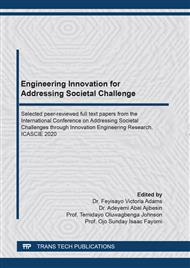p.49
p.55
p.64
p.76
p.85
p.97
p.113
p.122
p.129
Effect of Potassium Hydroxide on Geotechnical Properties of Biomass Fuel Ash Stabilized Lateritic Soil
Abstract:
This study assessed the effect of potassium hydroxide on geotechnical properties of Biomass fuel ash stabilized lateritic soil. In-situ tests were conducted on the original soil sample for identification and classification purposes. The soil sample was classified as A-2-6. Thereafter, the soil sample was mixed with both Biomass fuel ash and Potassium hydroxide at percentages of 0, 5, 10, 15 and 0, 3, 6, 9 respectively. These were later subjected to various tests such as natural moisture content, specific gravity, sieve analysis, Atterberg limit and compaction .The result showed that the addition of Biomass fuel ash increases the Plastic limit but decreases the plasticity index of the lateritic soil. Similarly, the addition of potassium hydroxide increases the plastic limit while the plasticity index decreases.The addition of Biomass fuel ash increases the optimum moisture content while the maximum dry density decreases. Similarly, the addition of potassium hydroxide increases the optimum moisture content however the maximum dry density decreases. It could be concluded that both Biomass fuel ash and Potassium hydroxide perform satisfactorily as stabilizing agents for stabilizing lateritic soil especially for subgrade and sub base purposes in road construction
Info:
Periodical:
Pages:
85-96
Citation:
Online since:
June 2021
Authors:
Keywords:
Price:
Сopyright:
© 2021 Trans Tech Publications Ltd. All Rights Reserved
Share:
Citation:


